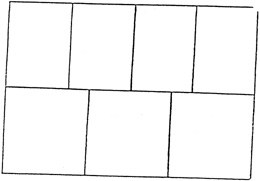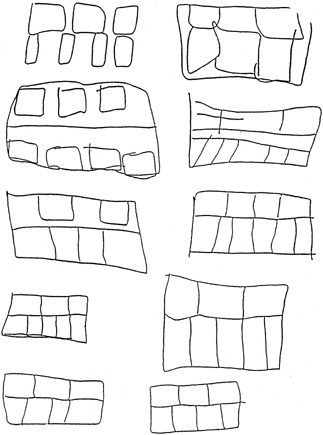1. Attention deficit hyperactivity disorder in adults. Medical Crossfire 4;2:30, February 2002 2. The Optometric Extension Program Foundation 1996 Annual Report. Available at: http://www.healthy.net/oep/annual.htm. Accessed 5/31/2005. 3. Scheiman MM, Rouse MW: Optometric Management of Learning-Related Vision Problems. St. Louis, Mo: C.V. Mosby, 1994 4. Koller HP: How does vision affect learning? Part II. J Ophthalmic Nurs Technol 18(1):12, 1999 5. Lyon GR: Research initiatives in learning disabilities: Contributions from scientists
supported by the National Institute of Child Health and Human Development. J Child Neurol 10:S120–S126, 1995 6. Hoyt CS: Visual training and reading. Am Orthopt J 49:23, 1999 7. Picard EM, Del Dotto JE, Breslau N: Prematurity and low birthweight. Central nervous system dysfunction in
other disorders. In Yeates KO, Ris MD, Taylor HG, eds:. Pediatric Neuropsychology: Research, Theory, and Practice. New York: Guilford Press, 2000 8. Taylor HG, Minich N, Bangert B, et al: Long term neuropsychological outcomes of very low birth-weight: Associations
with early risks for periventricular brain insults. J Int Neuropsychol Soc 10:987, 2004 9. Koller HP, Goldberg KB: A guide to visual and perceptual learning disabilities. Curr Concepts Ophthalmol 7:24, 1999 10. Phillips PH, Newman NJ: Mitochondrial diseases in pediatric ophthalmology. J AAPOS 1(2):115, 1991 11. Groom M, Kay MD, Corrent GE: Optic neuropathy in familial dysautonomia. J Ophthalmol 17(2):101, 1997 12. Koller HP: An ophthalmologist's approach to visual processing/learning differences. J Pediatr Ophthalmol Strabismus 39(3):140, 2002 13. Miller NR: Chapter 56. In Miller NR, Newman NJ, eds: Walsh and Hoyt's Clinical Neuro-Ophthalmology, Fifth Edition. Baltimore: Williams & Wilkins, 1998:3664 14. Dorland's Illustrated Medical Dictionary, 28th Edition. Philadelphia: W. B. Saunders, 1994 15. Troost BT: Migraine. In Duane TD, Jaeger EA, eds.: Clinical Ophthalmology. Vol. 2, Chapter 19. Philadelphia: Harper & Row, 1988 16. Miller NR: Chapter 56, Table 56-3. In Miller NR, Newman NJ, eds: Walsh and Hoyt's Clinical Neuro-Ophthalmology, Fifth Edition. Baltimore: Williams & Wilkins, 1998 17. O'Hara MA, Koller HP: Migraine in a pediatric ophthalmology practice. J Pediatr Ophthalmol Strabismus 35:203, 1988 18. Van Stavern GP: Chapter 26. Headache and facial pain. In Miller NR, Biousse V, Newman NJ, Kerrison JB, eds. Walsh and Hoyt's Clinical Neuro-Ophthalmology, Sixth Edition. Baltimore: Williams & Wilkins, 2005:1282–1293 19. O'Hara MA, Koller HP: Migraine in a pediatric ophthalmology practice. J Pediatr Ophthalmol Strasbismus 35:203, 1988 20. Miller NR: Chapter 56. In Miller NR, Newman NJ, eds: Walsh and Hoyt's Clinical Neuro-Ophthalmology, Fifth Edition. Baltimore: Williams & Wilkins, 1998:3666 21. National Joint Committee for Learning Disabilities (NJCLD). Learning
disabilities: Issues on definition. A position paper. Journal of Learning Disabilities 20:107, 1987 22. Gaddes WH, Edgell D: Learning Disabilities and Brain Function. 3rd ed. New York: Springer, 1993 23. Baker L, Cantwell DP: Comparison of well, emotionally disordered, and behaviorally disordered
children with linguistic problems. J Am Acad Child Adolesc Psychiatry 26:193, 1987 24. Hynd GW, Obrzut JE, Hayes F, Becker MG: Neuropsychology of childhood learning disabilities. In Wedding D, Horton AM, Webster J, eds. The Neuropsychology Handbook. New York: Springer Publishing, 1986:456–485 25. American Psychiatric Association. Diagnostic and Statistical Manual of Mental Disorders, Fourth Edition. Washington, DC: American Psychiatric Association, 1994 26. Commonwealth of Pennsylvania. Chapter 14: Special education services and programs state regulations. Harrisburg, PA: Department of Education; 2001 27. Grimes J: Responsiveness to interventions: The next step in special education identification, service, and
exiting decision making. In Bradley R, Danielson L, Hallahan D, eds. Identification of Learning Disabilities: Research to Practice. Mahwah, NJ: Lawrence Erlbaum Associates, Inc., 2002:531–547 28. Shaywitz S: Overcoming Dyslexia. New York: Alfred A. Knopf, 2003 29. Kolb B, Wishaw IQ: Fundamentals of Human Neuropsychology. 5th edition. New York: W. H. Freeman and Company, 2003 30. Foder JA: The Modularity of Mind. Cambridge, MA: MIT Press, 1983 31. Pennington BF: Diagnosing Learning Disorders: A Neuropsychological Framework. New York: The Guilford Press, 1991 32. Welsh LW, Welsh JJ, Healy M, Cooper B: Cortical, subcortical and brainstem dysfunction: A correlation in dyslexic
children. Am J Rhinolaryngol 9(3):310, 1982 33. Welsh LW, Welsh JJ, Healey MP: Central auditory testing and dyslexia. Laryngoscope XC(6):972, 1980 34. Shaywitz BA, Fletcher JM, Shaywitz SE: Defining and classifying learning disabilities and attention-deficit/hyperactivity
disorder. J Child Neurol 10(suppl 1):S50, 1995 35. Shaywitz SE: Dyslexia: Current concepts. N Engl J Med 338:307, 1998 36. Pennington BF, Bender B, Puck M, Salbenblatt J, Robinson A: Learning disabilities in children with sex chromosome anomalies. Child Dev 53:1182, 1982 37. Lovett M: Developmental reading disorders. In Feinberg T, Farah M, eds. Behavioral Neurology and Neuropsychology. New York: McGraw Hill, 1997:773–787 38. Shaywitz BA, Shaywitz SE, Pugh KR, et al: Disruption of posterior brain systems for reading in children with developmental
dyslexia. Biol Psychiatry 52:101, 2002 39. Goldberg E: Gradiential approach to neocortical functional organization. J Clin Exp Neuropsychol 11(4):489, 1989 40. Kolb B, Wishaw IQ: Fundamentals of Human Neuropsychology. 5th edition. New York: W. H. Freeman and Company, 2003 41. Foss JM: Nonverbal learning disabilities and remedial interventions. Ann Dyslexia 41:128, 1991 42. Rourke BP: Nonverbal Learning Disabilities: The Syndrome and the Model. New York: Guilford Press, 1989 43. Rourke BP: Syndrome of Nonverbal Learning Disabilities: Neurodevelopmental Manifestations. New York: Guilford Press, 1995. 44. Rourke BP: Frequently Posed Questions About the Syndrome of NLD. Philadelphia: 2003 45. Lyon GR, Rumsey JM: Neuroimaging: A Window to the Neurological Foundations of Learning and
Behavior in Children. Baltimore: Brookes, 1996 46. Smith LA, Rourke BP: Callosal agenesis in syndrome of nonverbal learning disabilities. In Rourke BP, ed. Syndrome of Nonverbal Learning Disabilities: Neurodevelopmental Manifestations. New York: Guilford Press, 1995:351–378 47. Van Amelsvoot T, Daly E, Robertson D, et al: Structural brain abnormalities associated with deletion at chromosome 22q11: Quantitative
neuroimaging study of adults with velo-cardio-facial
syndrome. Br J Psychiatry 178:412, 2001 48. Koller HP: An ophthalmologist's approach to visual processing/learning differences. J Pediatr Ophthalmol Strabismus 39(3):133, 2002 49. Koller HP, Goldberg KB: Working with visually impaired children and their families. In Nelson LB, Olitsky SE, eds. Harley's Pediatric Ophthalmology, 5th edition. Philadelphia: W. B. Saunders, 2005 50. Reinecke RD: Role of the ophthalmologist in reading disorders. Chapter 25. In Nelson LB, ed. Harley's Pediatric Ophthalmology, 4th edition. Philadelphia: W. B. Saunders, 1998, 499–507 51. Scheiman MM, Rouse MW: Optometric Management of Learning-Related Vision Problems. St. Louis: C.V. Mosby, 1994. 52. Thompson S: Nonverbal learning disorders. The Gram 1, 2000 53. Goldberg KB, Moss E, Dadario B, Corsey R: Information Processing and Personality in Children and Adolescents with
Nonverbal Learning Disabilities. Philadelphia: Society for Personality Assessment, 2001 54. American Psychiatric Association: Diagnostic and Statistical Manual of Mental Disorders, Fourth Edition. Washington, DC: American Psychiatric Association, 1994 55. Carey WB: Problems in diagnosing attention and activity. Pediatrics 103(3):664, 1999 56. American Academy of Pediatrics: Clinical Practice Guidelines: Diagnosing and evaluation of the child with
attention deficit/hyperactivity disorder. Pediatrics 105(5):1158, 2000 57. Mesulam MM: Principles of Behavioral and Cognitive Neurology. 2nd Edition. New York: Oxford University Press, 2000 58. Heilman KM, Voeller KKS, Nadeau SE: A possible pathophysiologic substrate of attention deficit hyperactivity
disorder. J Child Neurol 6(suppl):S76, 1991 59. Lou HC, Hendrikson L, Bruhn P: Striatal dysfunction in attention deficit and hyperkinetic disorder. Arch Neurol 46:48, 1989 60. Zametkin AJ: The neurobiology of attention-deficit hyperactivity disorder: A synopsis. Psychiatr Ann 19(11):584, 1989 61. Greenhill LL: Childhood attention deficit hyperactivity disorder: Pharmacological treatment. In Nathan PE, Gorman JM, eds. A Guide to Treatments That Work. London: Oxford University Press, 1998:42–62 62. Greenhill LL, Halperin JM, Abikoff H: Stimulant medications. J Am Acad Child Adolesc Psychiatry 38(5):503, 1999 63. Volkow ND, Ding YS, Fowler JS, et al: Is methylphenidate like cocaine? Arch Gen Psychiatry 52:456, 1995 64. Musten LM, Firestone P, Pisterman S, Bennett S, Mercer J: Effects of methylphenidate on preschool children with ADHD: Cognitive and
behavioral functions. J Am Acad Child Adolesc Psychiatry 36:1407, 1997 65. Pelham WE, Wheeler T, Chronis A: Empirically supported psychosocial treatments for attention deficit hyperactivity
disorder. J Clin Child Psychol 27(2):190, 1998 66. Strayhorn JM, Weidman CS: Follow-up one year after parent-child interaction training: Effects on
behavior of preschool children. J Am Acad Child Adolesc Psychiatry 30:138, 1991 67. Erhardt D, Baker BL: The effects of behavioral parent training on families with young hyperactive
children. J Behav Ther Exp Psychiatry 21:121, 1990 68. Barkley RA, Guevremont DC, Anastopoulos AD, Fletcher KE: A comparison of three family therapy programs for treating family conflicts
in adolescents with attention-deficit hyperactivity disorder. J Consult Clin Psychol 60(3):450, 1992 69. McGoey KE, Eckert TL, DuPaul GJ: Early intervention for preschool-age children with ADHD: A literature review. J Emotion Behav Disord 10(1):14, 2002 70. Kennedy R, Glassman R: Subtypes in ADHD: A newsmaker interview with Mary Solanto, Ph.D; 2003. Available at http://www.medscape.com/viewarticle/463181. Accessed 9/04. 71. Koller HP: Visual perception and learning differences: An ophthalmologist's view. Am J Orthop 49:175, 1999 72. Courchesne E, Carper R, Akshoomoff N: Evidence of brain overgrowth in the first year of life in autism. J Am Med Assoc 290(3):337, 2003 73. Courchesne E: Autism. In Lamb HR, Peschel E, Peschel R, Howe CW, Howe JW, eds.: New Directions for Mental Health Services: No. 54 Neurobiological Disorders
in Children and Adolescents. San Francisco, CA: Jossey-Bass Publishers, 1992:19–23 74. Gaffney GR, Kuperman S, Tsai LY, Minchin S: Forebrain structure in autism. J Am Acad Child Adolesc Psychiatry 28:534, 1988 75. Courchesne E, Yeung-Courchesne R, Press GA, Hesselink JR, Jernigan TL: Hypoplasia of cerebellar vermal lobules VI and VII in autism. N Engl J Med 318:1349, 1988 76. Horowitz B, Rumsey J, Grady C, Rappaport S: The cerebral metabolic landscape in autism. Arch Neurol 45:749, 1988 77. Kabot S, Masi W, Segal M: Advances in the diagnosis and treatment of autism spectrum disorders. Prof Psychol Res Pr. 34(1):26, 2003 78. Folstein S, Rutter ML: Autism: Familial aggregation and genetic implications. J Autism Dev Disord 18:3, 1988 79. Smalley SL, Asarnow RF, Spence MA: Autism and genetics: A decade of research. Arch Gen Psychiatry 45:953, 1988 80. Happe F, Frith U: The neuropsychology of autism. Brain 119:1377, 1996 81. Konstantareas MM, Homatidis S, Busch J: Cognitive, communication and social differences between autistic boys and
girls. J Appl Dev Psychol 10:411, 1989 82. Lovaas OI: Behavioral treatment and normal educational and intellectual functioning
in young autistic children. J Consult Clin Psychol 55(1):3, 1987 83. Gresham FM, MacMillan DL: Early intervention project: Can its claims be substantiated and its effects
replicated? J Autism Dev Disord 28:5, 1998 84. McEachin JJ, Smith T, Lovaas O: Long-term outcome for children with autism who received early intensive
behavioral treatment. Am J Ment Retard 97(4):359, 1993 85. Mesibov GB: A comprehensive program for serving people with autism and their families: The
TEACCH model. In Matson, JL, ed. Autism in Children and Adults: Etiology, Assessment, and Intervention. Pacific Grove, CA: Brooks/Cole Publishing Company, 1994:85–97 86. Gresham FM, Beebe-Frankenberger ME, MacMillan DL: A selective review of treat ments for children with autism: Description
and methodological considerations. School Psych Rev 28(4):559, 1999 87. Ozonoff S, Cathcart K: Effectiveness of a home program intervention for young children with autism: A
review. J Autism Dev Disord 28:25, 1998 88. Schopler E, Reichler RJ, Bashford A, Lansing MD, Marcus LM: Individualized Assessment and Treatment for Autistic and Developmentally
Disabled Children (vol. 1): Psychoeducational Profile Revised. Austin, TX: PRO-ED, 1990 89. Malek-Ahmadi P, Simonds JF: Olanzapine for autistic disorder with hyperactivity (letter to the
editor). J Am Acad Child Adolesc Psychiatry 37:902, 1998 90. Harteveld EM, Buitelaar JK: Autism: Role of drug treatment and a guide to its use. CNS Drugs 8:227, 1997 91. Bower B: Promising addition to autism treatment. Science News 141:164, 1992 92. McDougle CJ: Psychopharmacology. In Cohen DJ, Volkmar FR, eds. Handbook of Autism and Pervasive Developmental Disorders (2nd edition). New York: John Wiley & Sons, Inc., 1997 93. Commonwealth of Pennsylvania. Chapter 14: Special education services and programs state regulations. Harrisburg, PA: Department of Education, 2001 94. Americans with Disabilities Act of 1990, www.eeoc.gov/policy/ada.html 95. Greenspan SI, ed: Clinical Practice Guidelines, The Interdisciplinary Council on Developmental
and Learning Disorders. Bethesda, MD: ICDL Press, 2000:257 | 
